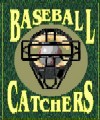 |
|
 |
|
The catcher can assume two different types of stances. One is used without runners on base and less than two strikes, and one is with two strikes on the hitter or runners on base. For the most part, both stances have similar qualities. The major difference is in preparing the body to block or throw pitches at the appropriate times. Without runners on base and less than two strikes on a hitter, the catcher will have his weight resting on his instep. A catcher's center of gravity should not allow him to get caught lunging at pitches or falling forward. | ||||
The feet should be toes out and ninety degrees to each other. For a right-handed catcher, the left foot should be slightly ahead of the right foot. Balance should be evenly distributed over both feet. This will allow the catcher to shift in any direction without any obstruction. The glove arm should assume a relaxed position. The fingers should be pointed up and be tension free. The elbow should rest under, or slightly angled away, and not to the side of the hand so that the fingers are horizontal. The catcher's elbow should also rest slightly outside the knee. | ||||
|
||||
|
There are few different positions for the throwing arm to rest without runners on base and with less than two strikes. The most important aspect is to keep it out of harms way. It can either rest behind the back or the leg. With a runner on base, or with no runners on and two strikes, the catcher must make an adjustment. There is no change in weight, feet placement or glove arm positioning. However, there are changes with the throwing arm position and mental preparations. | ||||
| ||||
|
If your throwing arm is placed behind your back or leg, it will take you longer to exchange the ball from your glove to your hand and throw, as opposed to having the throwing hand right next to your glove. Don't sacrifice your target. A common mistake is for the catcher to raise up in his stance into a "more athletic" position. However, when you do this you also put your glove in a higher position. This gives the pitcher a higher target and also gives him a false sense of security. Keep the target low and be prepared to block all balls in the dirt, retrieve all balls in the dirt, and throw all retrieved balls. |
